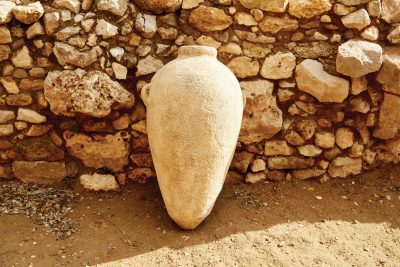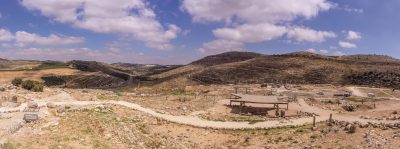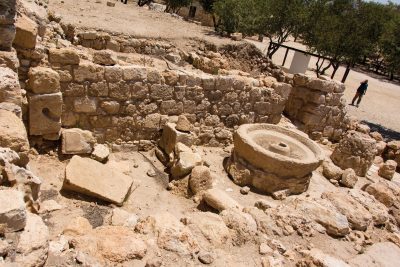
by: Nathan Williams, Director of Marketing and Communications
In the center of the biblical heartland is a special place that resonates deeply with both Christian and Jewish people. Those who tread upon the ruins of this ancient city, say that it is as if the ground is hallowed by the Presence that once dwelt there. A place of miracles, Shiloh remains of great importance today as it establishes the history and connection of Israel and the Jewish people to the Land.
 Joshua 18 recounts how the Israelites came to Shiloh and erected the Tent of Meeting (Tabernacle) there. This temporary dwelling place of God housed the Ark of the Covenant, which contained the two tablets of the Ten Commandments, Aaron’s staff and a jar of manna. Here Joshua cast lots to apportion the Promised Land among the seven tribes who had not yet received their allotted inheritance after the Israelites had conquered Canaan. Shiloh served as the religious and military center for the nation of Israel during the times of the judges. Long before choosing Jerusalem, Shiloh was the place where the Lord’s presence dwelt. As such, millions of Israelites would journey to Shiloh for the three pilgrimage festivals of the Lord (Passover, Shavuot or Pentecost and the Feast of Tabernacles) and camp on the surrounding hills. In fact, the Mishnah (first postbiblical written recording of Jewish oral tradition) recounts, “There is nothing differentiating between [the importance] of Shiloh and Jerusalem but…that the sanctity of Shiloh was released [once the Tabernacle was no longer there], while the sacredness of Jerusalem is everlasting.”
Joshua 18 recounts how the Israelites came to Shiloh and erected the Tent of Meeting (Tabernacle) there. This temporary dwelling place of God housed the Ark of the Covenant, which contained the two tablets of the Ten Commandments, Aaron’s staff and a jar of manna. Here Joshua cast lots to apportion the Promised Land among the seven tribes who had not yet received their allotted inheritance after the Israelites had conquered Canaan. Shiloh served as the religious and military center for the nation of Israel during the times of the judges. Long before choosing Jerusalem, Shiloh was the place where the Lord’s presence dwelt. As such, millions of Israelites would journey to Shiloh for the three pilgrimage festivals of the Lord (Passover, Shavuot or Pentecost and the Feast of Tabernacles) and camp on the surrounding hills. In fact, the Mishnah (first postbiblical written recording of Jewish oral tradition) recounts, “There is nothing differentiating between [the importance] of Shiloh and Jerusalem but…that the sanctity of Shiloh was released [once the Tabernacle was no longer there], while the sacredness of Jerusalem is everlasting.”
The Bible tells us the story of Hannah who prayed at Shiloh (1 Sam. 1:8–18), and today, her testimony remains one of the focal points of the exhibit at the ancient Shiloh archaeological site. Here Hannah wept before the Lord and without spoken words, poured out her heart and her disappointment over her barrenness. The Lord heard Hannah’s cry and blessed her with the miraculous conception of the last of Israel’s judges: Samuel. So today, both Christians and Jewish women alike make the pilgrimage to Shiloh with an expectancy to receive the blessing of children and in the same way as Hannah did, pour out their hearts before the Lord and seek for the miracle of a child.
The Tent of Meeting (Tabernacle) that stood at Shiloh is interestingly also referred to as a temple. 1 Samuel mentions that this structure in fact had doorposts and doors, giving credence to the belief that the structure of the sanctuary became more permanent over time. Understandably so, as according to Jewish sources, the Tabernacle remained there for 369 years. Archaeologists have discovered holes carved into the rock which are believed to have been used to hold the beams for the Tabernacle structure. A walled platform surrounds the site believed to be the location of the Tabernacle, and the dimensions align with those given in the Bible.
 In June 2022, Scott Stripling and a team from the Associates for Biblical Research discovered piers (support structures) for a door or gate into the ancient city complex situated on the side of the Shiloh spring. This is significant as the Bible recounts a story of the High Priest Eli falling backwards and breaking his neck by the side of the gate of Shiloh. Stripling believes that this could be the gate mentioned in 1 Samuel 4.
In June 2022, Scott Stripling and a team from the Associates for Biblical Research discovered piers (support structures) for a door or gate into the ancient city complex situated on the side of the Shiloh spring. This is significant as the Bible recounts a story of the High Priest Eli falling backwards and breaking his neck by the side of the gate of Shiloh. Stripling believes that this could be the gate mentioned in 1 Samuel 4.
There have also been several discoveries related to the daily animal sacrifices and the functions of the Levitical priesthood, which further suggest that this is indeed the site of ancient Shiloh. A huge deposit of thousands of pottery shards and animal bones was discovered nearby the Tabernacle platform complex. The Torah (Gen.–Deut.) teaches that the Levitical priests were given the right side of clean (kosher) animals as their portion. Remarkably, all of the bones found in this repository are from the right side of kosher animals. Other noteworthy discoveries include two ceramic pomegranates, decorative elements used in both the Tabernacle and on the priestly garments. A shattered four-horned altar was also found near to the structure believed to be the Tabernacle platform. “All of this together inductively suggests to us that we are seeing what is found in the Bible,” Stripling told All Israel News, echoing his conviction of the accuracy of this site to be that of biblical Shiloh.
 Of course, a place like Shiloh—with its ancient and undisputable connection to the Hebrew Scriptures and bearing evidence to an ancient Jewish presence in the land of Israel—is a source of mocking and ridicule in the anti-Israel movement. When Prime Minister Benjamin Netanyahu visited Tel Shiloh with former Arkansas Governor Mike Huckabee in 2019, he described the site as the “first capital” of Israel. This sparked criticism that the history of Shiloh is presented in a narrow way, focusing on a narrative that is popular only with Israeli communities and their Christian supporters.
Of course, a place like Shiloh—with its ancient and undisputable connection to the Hebrew Scriptures and bearing evidence to an ancient Jewish presence in the land of Israel—is a source of mocking and ridicule in the anti-Israel movement. When Prime Minister Benjamin Netanyahu visited Tel Shiloh with former Arkansas Governor Mike Huckabee in 2019, he described the site as the “first capital” of Israel. This sparked criticism that the history of Shiloh is presented in a narrow way, focusing on a narrative that is popular only with Israeli communities and their Christian supporters.
Indeed, Shiloh has seen numerous people groups occupy this site. The archaeological record includes evidence from the Second Temple as well as the Byzantine, Islamic, Roman and Persian periods. However, in a world fighting against biblical truth and denying the history of the Jewish people in their biblical heartland, the discoveries at Shiloh specifically related to the times of Joshua and the judges increase in significance and become particularly relevant. While naysayers balk at the historical evidence of excavations made here, there is no denying that Shiloh has been in the past and will in future remain an important part of our faith and of the story of Israel.
Photo Credit: Click on photo to see photo credit
Photo License: Shiloh at Samaria. Excavations
All logos and trademarks in this site are property of their respective owner. All other materials are property of Bridges for Peace. Copyright © 2025.
Website Site Design by J-Town Internet Services Ltd. - Based in Jerusalem and Serving the World.